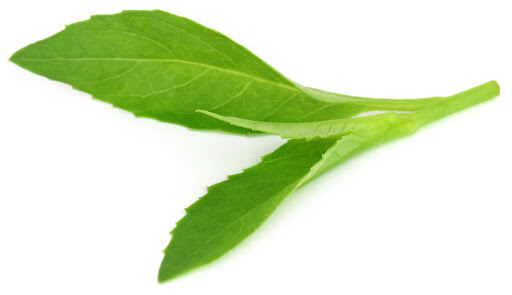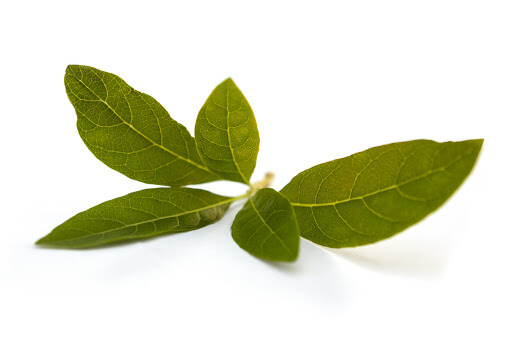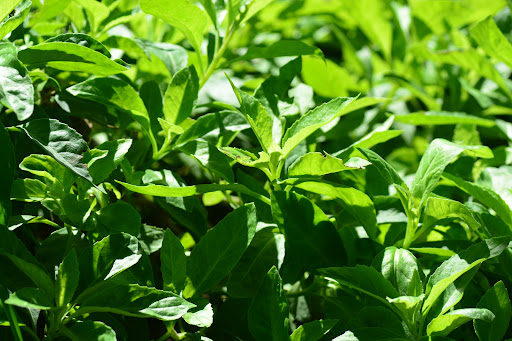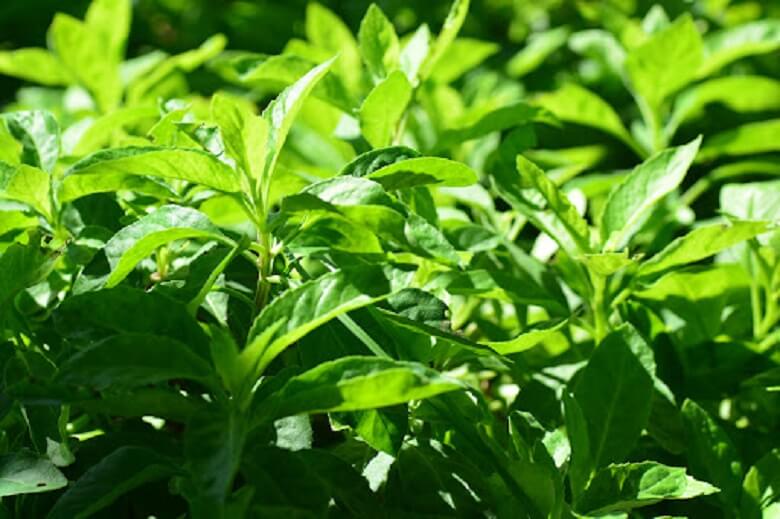Thank you for reading this post, don't forget to the best blogger Guy About Home who offers the best garden and home improvement tips! If you are a home decor and design fan, don't miss the tips on home ideas. If you are a home garden owner, then you might be interest in our complete guides to house plants!
What is Longevity spinach? Is it different from regular vegetable spinach? How to grow Longevity spinach? If you want to find out more about Longevity spinach, continue reading.
If you are a plantsman or often visit a plant nursery, you might have heard about Longevity spinach. Like the rose of jericho, Longevity spinach is one of the fabulous houseplants. It is a unique plant with green leaves and is loaded with numerous health benefits.
What is Longevity Spinach

Source: Depositphotos
longevity spinach plant origin
Longevity spinach thrives in the wild, and it is also grown as a vegetable and medicinal plant. Longevity spinach or Gynura spinach is an edible vine grown in a few places like China, Africa, and Southeast Asian countries. It is also known by other names, such as Gynura procumbens, longevity greens, Leaves of the Gods, Sambung Nyawa, Sabuñgai, Moluccan spinach, and Daun Dewa. It comes under the Plantae kingdom and belongs to the Asterales order and Asteraceae family. The Longevity spinach falls under the Senecioneae tribe and the Gynura genus.
longevity spinach leaves
The Longevity spinach is the all-green cousin of Okinawa spinach. In addition to that, it has a strong flavor and texture. Unlike alocasia black velvet, Longevity spinach leaves have pale green and light color rather than dark leaves. The leaves of Longevity spinach are ovate-elliptic and are shaped like a lance head specifically, so they are called lanceolate. Generally, these leaves are 3.5 to 8 centimeters (1.3 to 3.14 inches) long and are 0.8 to 3.5 centimeters (0.3 to 1.3 inches) wide.
longevity spinach flowers
The Longevity spinach is a flowering plant like the monstera siltepecana. In the summer months, you can put this plant on patio walls or hang it on the balcony, and the Longevity spinach will start blossoming with aromatic daisy-like flowers, which can captivate butterflies, bees, and other birds.
Longevity Spinach Health Benefits

Source: Depositphotos
longevity spinach nutrition facts
The Longevity spinach plant contains plenty of nutrients, such as Vitamin K, Saponins, Flavonoids, Oil astir, Hydrochloric acid, Acid p-hydroxybenzoate, Tannin, Alkaloids, Vanilla, Sterol, Polyphenols, and Triterpenoids.
The Anticoagulants present in this plant assist in diminishing blood clots, enhance blood circulation, and avoid bleeding. The anti-cholesterol chemical properties of this plant are effective in controlling cholesterol in your blood.
The diuretic properties of this plant are effective in releasing urine from time to time. Women can consume the solution made from Longevity spinach to fight against menstrual ailments.
The leaves have anti-inflammatory properties to decrease inflammation and give instant relief from pain. These leaves help in curing Rheumatism, a health illness that causes bone joint pains.
Longevity Spinach: Things to Know
Longevity Spinach Growing Facts
- The smooth leaves of this plant are green on the sun side and slightly purple on the other side.
- During the spring season, the Longevity spinach will start blooming fragrant flowers.
- The Longevity spinach grows as herbaceous shrubs with dense, fleshy, and soft leaves.
- As the Longevity spinach is a flowering seed plant and dicotyledonous, it is known as Angiosperms.
- It is a perennial plant and continues to live for several years, and the tips of the Longevity spinach plant leaves have light purplish-green color.
- With carbon dioxide, water, and nitrates, this plant will produce organic and nourishing complex compounds.
- This Longevity spinach features a short petiole, flower-shaped pale green petals, and bright yellow needle-shaped stamens.
- The Longevity spinach plant can be planted through stem cuttings and tubers as well.
is longevity spinach safe to eat?
Yes. The young and pale leaves of this plant can be utilized in cooking. They go well with meat, and prawns and also add flavor to the vegetable soup.
Drinking a herbal mixture or stew made of longevity spinach leaves will treat stroke and diabetes. Regularly drinking Longevity spinach leaves potion will help in lessening the risk of cardiovascular disorders, heartache, and many more. Similar to majesty palm,drinking the Longevity spinach potion on a regular basis helps in curing sprains, hemorrhoids, wounds, and animal bites.
How Big and tall Does a Longevity Spinach Get?

Source: Depositphotos
The Longevity spinach plant can grow up to a maximum height of 12 inches and a minimum height of 6 inches. Hence, you can see an average growth of this plant anywhere between 6 to 12 inches.
The standing stem of the Longevity spinach plant is smooth, short, cross-sectional, rectangular, and grows hairy structures on the outside. The leaves of this plant can grow as big as 10 centimeters wide with a maximum height of 20 centimeters.
Is longevity spinach toxic?
With its anti-toxic properties, the plant leaves are good at removing toxins from the body. Consuming Longevity spinach regularly can lower your blood pressure as well. These leaves also have Antipyretic properties that are effective in lowering your body temperature.
With its antibacterial properties, Longevity spinach can eliminate and curb bacterial accumulation. These leaves also help to impede the development of cancer cells in your body.
What is the life span of Longevity spinach?
As Longevity spinach is a perennial plant, it will have a lengthy lifespan. Hence, if you take good care of this plant, it will probably grow and live for several years.
When to Grow Longevity Spinach?
The best month to plant the Longevity spinach is during the summer season, particularly in March. And, the plant will start blossoming anywhere from mid-July to early August. However, the best season might vary based on your location, surrounding temperature, and frost season.
Where to grow longevity spinach?
If the outdoor temperature is falling below 40 degrees Fahrenheit, move the plant indoors. It is best to place this plant near windows or other places that receive plenty of sunlight.
For growing the Longevity spinach outdoors, consider planting it in nutrient-rich and well-drained soil. Also, placing it under the shade of a big tree is good because it will have less exposure to direct sunlight.
How to Care for Longevity Spinach?
Like rose of jerichomanjula pothos,lemon button fern, the Longevity spinach also needs some care and maintenance. Below, we will talk about some of the best ways and effective tips to care for the Longevity spinach plant. No worries! Though you might encounter the difficulties when learning how to care such an plant as a new plant caring starter, we got the most popular plant lover quotes that can partner with you and you are going to succeed in plant care and grow.
Besides this plant, we also make a full care guide on how to care for Macodes petola.
Longevity Spinach Soils
For excellent growth of the Longevity spinach, you need to grow it in loose soil that has plenty of drainages. Like macodes petola, when this plant is kept in a poor drainage pot, it becomes wet, soft, which results in root rot. Make sure that the soil has enough moisture to facilitate the healthy growth of this plant and avoid dry roots.
It is better to grow this plant in soil that has a good pH level. Though it can also grow in boor and dry soil type with full exposure to the sun, its growth will be relatively stagnant.
Longevity Spinach Water
You need to water the Longevity spinach from time to time, but it is not necessary to water it daily. While watering, keep in mind not to pour water on the plant and sprinkle it on the soil.
During summer, the plant might need regular watering. But, in winter, it is better to reduce the number of times you water the plant. Even if you missed watering the plant for a few days, do not overwater it at once, which might lead to root rot.
Longevity Spinach Sunlight
The Longevity spinach requires moderate sunlight to grow. So, it is best to place the plant in partial shade areas. Though it will survive and thrive in heavy direct sunlight, the leaves will have a bitter taste. Also, the overall growth will become stagnant.
Longevity Spinach Temperature
The Longevity spinach will maintain healthy growth in warm environments, and it is delicate to frost. During a cold climate, this plant will either slow or stops its growth. Under extremely cold temperatures, the Longevity spinach might become dead.
The surrounding temperature of 70 degrees Fahrenheit is excellent for the fast and healthy growth of this plant. Make sure not to expose this plant to severe hot or cold temperatures.
Longevity Spinach Fertilization
You can add fertilizer to the Longevity spinach quarterly. It does not need any particular kind of fertilizer, so any nitrogen-rich fertilizer is enough, including fish fertilizer and blood meal.
Mostly, this plant does need any fertilizer if grown in the soil unless the soil lacks nutrients. You can scatter fertilizer around the plant if it is growing in a pot.

Source: Depositphotos
How to propagate a Longevity Spinach
With the Longevity spinach cuttings, you can propagate a new plant without harming the mother plant. Besides that, when the mother plant is wilting or if you want to grow many Longevity spinach plants, you can take cuttings from that mature plant. Here are the simple steps for Longevity spinach propagation:
Besides this plant, we also make a full care guide on how to propagate Majesty palm.
Not confident in planting an indoor plant? Why not getting power from our inspiring indoor plants quotes?
- First of all, you need to collect the plant cuttings. For that, make a cutting between 1 to 18 inches from its stem or near the bud.
- Make sure to slice the cutting from beneath the leaf. In every cutting, pluck out all the leaves except 2 to 3 leaves on top of the cutting. If you want optimum results, dip one end of the cutting in a rooting hormone.
- Fill a pot with soil, and after watering, put the cuttings. If it is a big pot, you can plant up to three cuttings, leaving enough space between them. When you plant them in the container, the surrounding temperatures must be 65 to 75 degrees Fahrenheit for the following two weeks.
- Water the cuttings every day to deter them from dehydrating, and the roots might start growing in about 14 days. Adding liquid organic fertilizer will enhance plant growth.
- When a new root system is growing on the cutting, you can plant the cutting in a different pot. After repotting, water the plant every day for about a few weeks so that the soil will retain enough moisture to facilitate root growth.

Source: Depositphotos
How much does a Longevity Spinach cost?
The cost of a 3 to 8-inch Longevity spinach plant ranges from 40 to 50 dollars, depending on the place. Plus, the Longevity spinach seeds for sale costs below one dollar. As you can buy the Longevity spinach plant at an affordable price, you can fill your house or garden with these plants, which adds more beauty.
Where to buy longevity Spinach
If your neighborhood has a local plant nursery, there are high chances that you might find a Longevity spinach plant. Same as lemon button fern, This plant is also available in some home decor plants stores. In addition to that, you can buy Longevity spinach plants from various online sites as well.
Major E-commerce websites and numerous online plant stores also sell the Longevity spinach plant, stem, and cuttings. So, you can search “Longevity spinach” on the scroll bar to find the best retailers. Buy from a dealer who can ship the plant in a decent shape quickly at a reasonable price. If you want to purchase the seeds, you can search for Longevity spinach seeds for sale. After that, check out all the portals and choose the best merchant to buy these seeds after reading reviews and ratings.
Longevity Spinach vs Spinach
There are a few different species of Longevity spinach. All those varieties have the same scientific name, which is Gynura Procumbens. However, the common names and colors of the leaves are quite different. Keeping aside their unique colorations, all types of Longevity spinach have a similar taste, strong flavor, and relevant health benefits. If you want to grow other plant varieties, we suggested you the easy-to-care plants, such as trachyandra tortilis, crispy wave fern, monkey face orchid
Okinawa Spinach VS Longevity Spinach: What are their differences?
Like we mentioned previously, the all-green cousin of Okinawa spinach is Longevity spinach. Here we will highlight some of the differences between these spinach types:
Okinawa Spinach VS Longevity Spinach Origins
The Longevity spinach is grown in a few areas, such as Africa, China, and some Southeast Asian countries. Okinawa spinach is a native plant to Thailand, Myanmar, China and is grown in other parts of the world.
Okinawa Spinach VS Longevity Spinach Heights
The Longevity spinach can grow up to a maximum height of 30 centimeters (12 inches) and a minimum of 15 centimeters (6 inches) in the form of herbaceous shrubs. However, Okinawa spinach grows up to 70 centimeters (27.5 inches) long in the pattern of bushes in thick clusters.
Okinawa Spinach VS Longevity Spinach Leaves
Another thing that can quickly differentiate these two plants is their leaf colors. Longevity spinach is all green and comes with a light purple color on the other side. However, the Okinawa spinach leaves have a bit of ripe green on the upper side and on the underside, the leaves are heavily purple in color.
Okinawa Spinach VS Longevity Spinach Tastes
The slightly fuzzy textured Longevity spinach leaves have a powerful and thick taste. Just as hoya wayetti, but, the Okinawa spinach leaves taste a bit sweeter due to their purple color. Compared to the Longevity spinach, the Okinawa spinach leaves possess a little more pyrrolizidine alkaloids.
Bottom Line
At last, we have completed the full guide on the Longevity spinach plant. You can easily grow this plant in your house, and it is one of the plants that does not need heavy maintenance. The Longevity spinach plant adds charm to your residence. You can grow this plant by pairing it with other indoor plants, for example, ficus triangularis and many other succulent plants.
For more amazing ideas you can have, visit Guy About Home today or you can check the related blogs:
- Five Ways To Save Water In Your Garden
- What are the essential elements of a home garden?
- 7 Plants You Should Plant In A Perennial Hanging Baskets
For more step-by-step ideas, diy tips and guides, kindly visit the website guyabouthome.com providing the best garden & home improvement tips.




